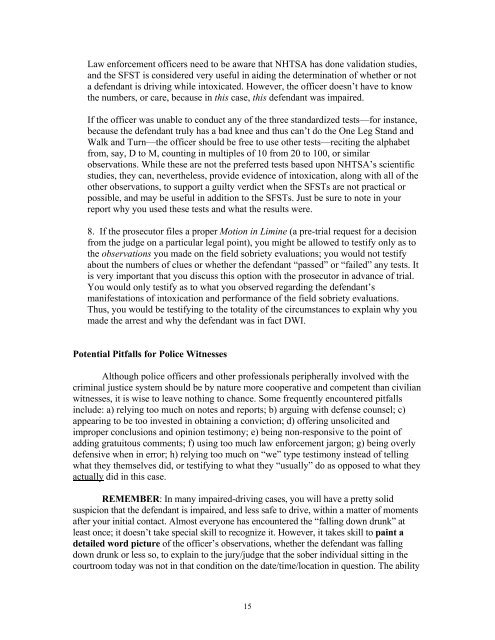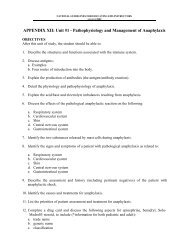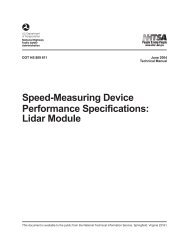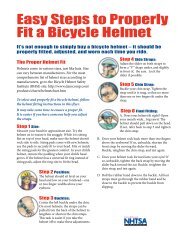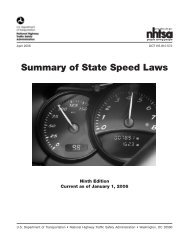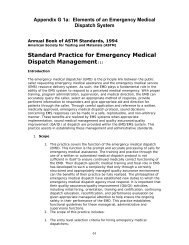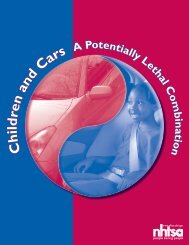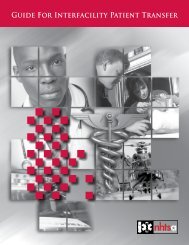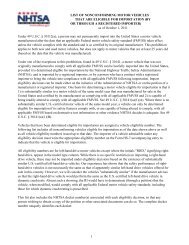The Criminal Justice System: A Guide for Law Enforcement ... - NHTSA
The Criminal Justice System: A Guide for Law Enforcement ... - NHTSA
The Criminal Justice System: A Guide for Law Enforcement ... - NHTSA
You also want an ePaper? Increase the reach of your titles
YUMPU automatically turns print PDFs into web optimized ePapers that Google loves.
<strong>Law</strong> en<strong>for</strong>cement officers need to be aware that <strong>NHTSA</strong> has done validation studies,<br />
and the SFST is considered very useful in aiding the determination of whether or not<br />
a defendant is driving while intoxicated. However, the officer doesn’t have to know<br />
the numbers, or care, because in this case, this defendant was impaired.<br />
If the officer was unable to conduct any of the three standardized tests—<strong>for</strong> instance,<br />
because the defendant truly has a bad knee and thus can’t do the One Leg Stand and<br />
Walk and Turn—the officer should be free to use other tests—reciting the alphabet<br />
from, say, D to M, counting in multiples of 10 from 20 to 100, or similar<br />
observations. While these are not the preferred tests based upon <strong>NHTSA</strong>’s scientific<br />
studies, they can, nevertheless, provide evidence of intoxication, along with all of the<br />
other observations, to support a guilty verdict when the SFSTs are not practical or<br />
possible, and may be useful in addition to the SFSTs. Just be sure to note in your<br />
report why you used these tests and what the results were.<br />
8. If the prosecutor files a proper Motion in Limine (a pre-trial request <strong>for</strong> a decision<br />
from the judge on a particular legal point), you might be allowed to testify only as to<br />
the observations you made on the field sobriety evaluations; you would not testify<br />
about the numbers of clues or whether the defendant “passed” or “failed” any tests. It<br />
is very important that you discuss this option with the prosecutor in advance of trial.<br />
You would only testify as to what you observed regarding the defendant’s<br />
manifestations of intoxication and per<strong>for</strong>mance of the field sobriety evaluations.<br />
Thus, you would be testifying to the totality of the circumstances to explain why you<br />
made the arrest and why the defendant was in fact DWI.<br />
Potential Pitfalls <strong>for</strong> Police Witnesses<br />
Although police officers and other professionals peripherally involved with the<br />
criminal justice system should be by nature more cooperative and competent than civilian<br />
witnesses, it is wise to leave nothing to chance. Some frequently encountered pitfalls<br />
include: a) relying too much on notes and reports; b) arguing with defense counsel; c)<br />
appearing to be too invested in obtaining a conviction; d) offering unsolicited and<br />
improper conclusions and opinion testimony; e) being non-responsive to the point of<br />
adding gratuitous comments; f) using too much law en<strong>for</strong>cement jargon; g) being overly<br />
defensive when in error; h) relying too much on “we” type testimony instead of telling<br />
what they themselves did, or testifying to what they “usually” do as opposed to what they<br />
actually did in this case.<br />
REMEMBER: In many impaired-driving cases, you will have a pretty solid<br />
suspicion that the defendant is impaired, and less safe to drive, within a matter of moments<br />
after your initial contact. Almost everyone has encountered the “falling down drunk” at<br />
least once; it doesn’t take special skill to recognize it. However, it takes skill to paint a<br />
detailed word picture of the officer’s observations, whether the defendant was falling<br />
down drunk or less so, to explain to the jury/judge that the sober individual sitting in the<br />
courtroom today was not in that condition on the date/time/location in question. <strong>The</strong> ability<br />
15


